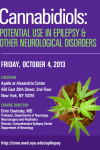
“While a large body of anecdotal and laboratory evidence points to cannabis as an effective treatment for epilepsy, research in humans is just beginning to catch up.
GW Pharmaceuticals – the UK-based company behind the natural cannabis spray Sativex – announced the start of the first round of clinical trials of a new cannabis treatment for epilepsy.
In the press release, Dr. Stephen Wright, Director of Research and Development at GW, said the company has spent years testing cannabis in pre-clinical models – which include cell cultures and animals.
So far, the drug is only known as GWP42006.
“We are pleased to have advanced GWP42006 to first dose in man, a significant milestone in the development of this novel product candidate. The decision to progress into Phase 1 follows several years of highly promising pre-clinical research.”
Dr. Ben Whalley, Senior Lecturer in Pharmacology at the Reading School of Pharmacy, added, “Our research collaboration with GW over the last several years has shown that GWP42006 not only exerts significant anticonvulsant effects in a wide range of preclinical models of seizure and epilepsy but is also better tolerated compared to existing anti-epileptic drugs.”
While the company has not disclosed the ingredients in the new drug, their latest animal study – which appears in the October issue of the British Journal of Pharmacology – showed positive results with two chemicals derived from cannabis: Cannabidiol (CBD) and cannabidivarin (CBDV).
Both were found to suppress seizures and increase survival across a range of different rat models of epilepsy.”

“Both CBD and CBDV are produced naturally by cannabis. Unlike THC, these two compounds do not get patients high.”


